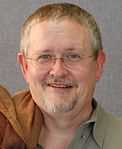Pastwatch: The Redemption of Christopher Columbus
 | |
| Author | Orson Scott Card |
|---|---|
| Country | United States |
| Language | English |
| Series | Pastwatch series |
| Genre | Science fiction |
| Publisher | Tor Books |
Publication date | 1996 |
| Media type | Print (hardback & paperback) |
| Pages | 351 pp |
| ISBN | 0-312-85058-1 |
| OCLC | 33277574 |
| 813/.54 20 | |
| LC Class | PS3553.A655 P37 1996 |
| Followed by | Pastwatch: The Flood |
Pastwatch: The Redemption of Christopher Columbus (1996) is the first science fiction novel in the Pastwatch series by Orson Scott Card. The book's focus is the life and activities of explorer, Christopher Columbus. Much of the action deals with a group of scientists from the future who travel back to the 15th century in order to change the pattern of European contact with the Americas.
Plot summary
Sometime in the future, humanity invents a series of machines which allow them to view events in their past. Tagiri is a researcher at Pastwatch, the organization in charge of these machines. Her special interest is in the colonization of the Caribbean and the life of Christopher Columbus. One day she accidentally discovers that the machines may be used to send information backwards in time. Unsure about what to do with this knowledge she is nonetheless put in charge of a project to explore it along with her husband Hassan. They are eventually joined by their daughter Diko. A parallel narrative tells of Columbus' efforts to secure financial and political backing for his voyage across the Atlantic. Tagiri and other researchers note that Columbus had always yearned for greatness but that as a young man he had been determined to head east to liberate the Holy Land from the Muslims. He only changed his mind and decided to head west across the Atlantic after nearly drowning in a storm. The mystery of exactly why Columbus changed his mind is solved by Diko. She uses a new, and more visually sensitive, version of the time viewer and discovers that after surviving the wreck Columbus received a vision directing him to head west to convert the people who lived on a previous undiscovered continent. The researchers realize that this vision is actually a hologram sent back in time by people from an alternate timeline in order to influence the direction of Columbus' life. Realizing that someone has already changed the timeline they try to figure out what might have been different if Columbus had headed east instead of west. The answer is provided by Hunahpu, an Amerindian researcher with Pastwatch. He argues that in the original timeline the Tlaxcalan empire of Central America grew powerful enough to invade Europe, subjecting the continent to a harsh regime of human sacrifice. In order to undo that atrocity, their counterparts from the original timeline sent the hologram back to direct Columbus, the greatest man of his era, to head west. The European conquest of the Americas thereby neutralized the threat.
Tagiri and her team determine that they must change history so that neither timeline happens as it did. They use their machinery to send Diko, Hunahpu, and a Turkish researcher named Kemal, back in time in order to change history. Hunahpu and Diko appear years before Columbus' voyage in Central America and the Caribbean respectively. They use genetically engineered viruses to spread immunity to Old World diseases and work to strengthen Indian society for the coming European contact, including by spreading a pseudo-Christian religion among them and outlawing human sacrifice. Hunahpu helps accelerate the development of a Central American empire to rival European powers. When Columbus arrives, Kemal sinks his ships, stranding the explorer and his men in the Caribbean. After overcoming prejudice, Columbus learns to live with the Indigenous people and becomes a powerful political leader among the natives of the Caribbean and eventually oversees a political union with the Central American empire. By the sixteenth century the people of Central America and the Caribbean are able to send ships across the Atlantic to meet the Europeans on more equal footing.
A postscript describes the future of this new timeline as a utopian one and how archeologists in the 1950s discovered the skull of Kemal and found within it a set of small metal plates which contained a message from Tagiri and the Pastwatch program.
Related works
- Card, Orson Scott. Pastwatch: The Flood.
- Card, Orson Scott. Pastwatch: The Garden of Eden.
Translations
- French: "La Rédemption de Christophe Colomb", 1998, ISBN 2-84172-093-4
- Polish: "Badacze czasu. Odkupienie Krzysztofa Kolumba", 1997, ISBN 83-7180-706-6
- Russian: "Искупление Христофора Колумба", 1997, ISBN 5-300-01997-6
- Spanish: "La redención de Cristobal Colón", ISBN 84-406-8119-4
- Hungarian: "Múltfigyelõk: Kolumbusz Kristóf feloldozása", 2004, ISBN 963-9557-22-6
- Hebrew: "תצפית עבר: גאולתו של כריסטופר קולומבוס"
See also
- List of works by Orson Scott Card
- Orson Scott Card
